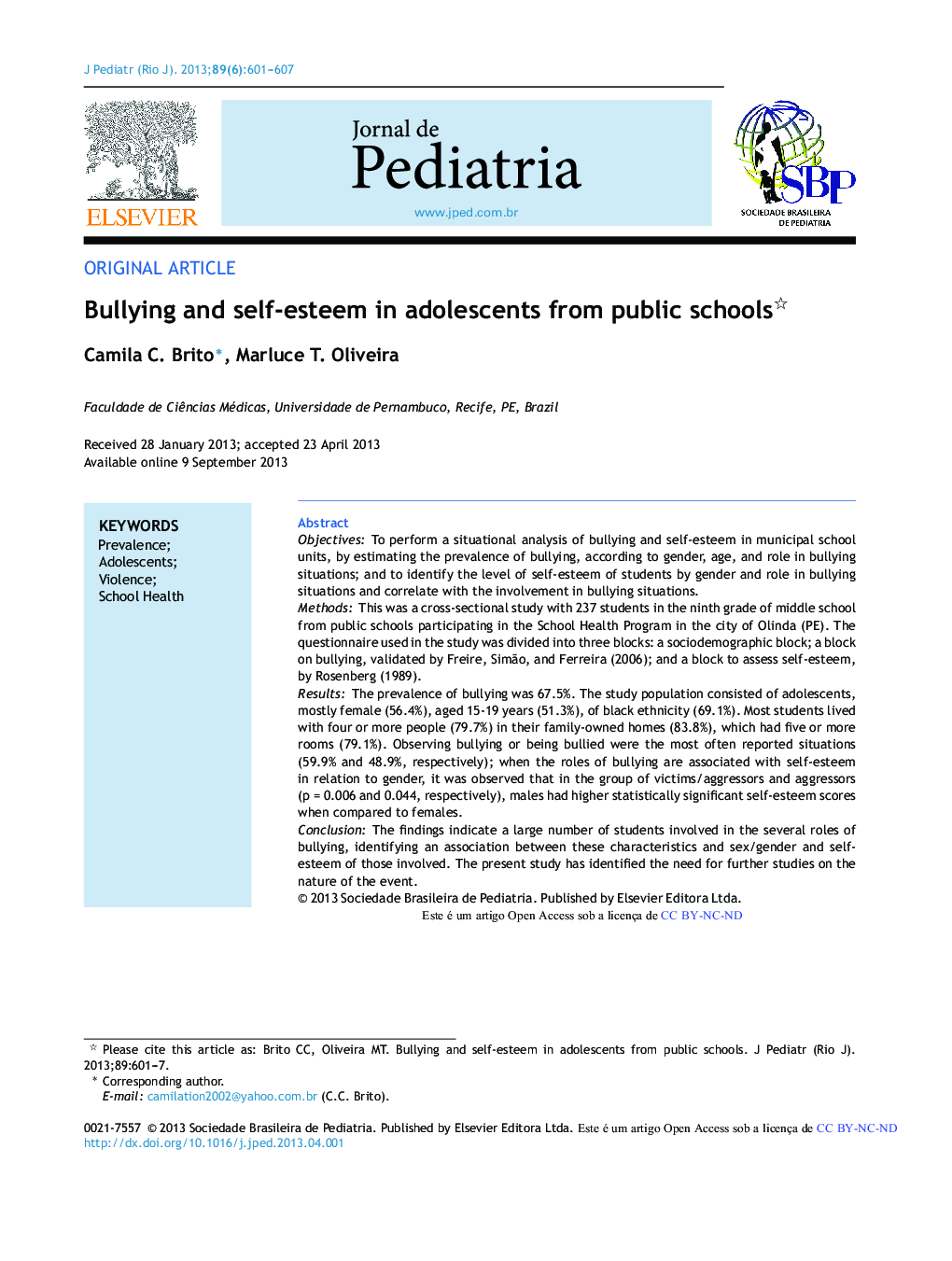| Article ID | Journal | Published Year | Pages | File Type |
|---|---|---|---|---|
| 4154143 | Jornal de Pediatria | 2013 | 7 Pages |
ObjectivesTo perform a situational analysis of bullying and self-esteem in municipal school units, by estimating the prevalence of bullying, according to gender, age, and role in bullying situations; and to identify the level of self-esteem of students by gender and role in bullying situations and correlate with the involvement in bullying situations.MethodsThis was a cross-sectional study with 237 students in the ninth grade of middle school from public schools participating in the School Health Program in the city of Olinda (PE). The questionnaire used in the study was divided into three blocks: a sociodemographic block; a block on bullying, validated by Freire, Simão, and Ferreira (2006); and a block to assess self-esteem, by Rosenberg (1989).ResultsThe prevalence of bullying was 67.5%. The study population consisted of adolescents, mostly female (56.4%), aged 15-19 years (51.3%), of black ethnicity (69.1%). Most students lived with four or more people (79.7%) in their family-owned homes (83.8%), which had five or more rooms (79.1%). Observing bullying or being bullied were the most often reported situations (59.9% and 48.9%, respectively); when the roles of bullying are associated with self-esteem in relation to gender, it was observed that in the group of victims/aggressors and aggressors (p = 0.006 and 0.044, respectively), males had higher statistically significant self-esteem scores when compared to females.ConclusionThe findings indicate a large number of students involved in the several roles of bullying, identifying an association between these characteristics and sex/gender and self-esteem of those involved. The present study has identified the need for further studies on the nature of the event.
ResumoObjetivosRealizar diagnóstico situacional do bullying e autoestima em unidades municipais de ensino, por meio de estimativa da prevalência do bullying, segundo o sexo, faixa etária e situação do ator; identificar o nível de autoestima dos escolares segundo sexo e situação do ator e correlacionar com o envolvimento em situações de bullying.MétodosEstudo transversal, realizado com 237 alunos, do 9° ano do ensino fundamental, em escolas públicas municipais do Programa Saúde na Escola de Olinda (PE). Foi utilizado um questionário dividido em três blocos, um sociodemográfico, outro sobre bullying, validado por Freire, Veiga e Ferreira, e um para avaliar a autoestima, de Rosenberg.ResultadosA prevalência de bullying foi de 67.5%. A população do estudo foi composta por adolescentes do sexo feminino (56,4%), na faixa etária de 15-19 anos (51,3%), de raça/cor preta (69,1%). Grande parte mora com quatro ou mais pessoas (79,7%), em casa própria (83,8%) e com cinco ou mais cômodos na residência (79,1%). Presenciar ou sofrer bullying foram às situações mais registradas (59,9% e 48,9%, respectivamente); Quando se associou os papéis de bullying e autoestima em relação ao sexo verificou-se que no grupo de vítimas/agressores e agressores (p = 0,006 e 0,044; respectivamente), o sexo masculino apresentou escores de autoestima superiores estatisticamente significativos em relação aos do sexo feminino.ConclusãoOs achados apontam para um número grande de alunos envolvidos nos diversos papéis do bullying, identificando-se associação entre estas características e o sexo/gênero e autoestima dos envolvidos. Identifica-se a necessidade de estudos adicionais sobre a natureza do evento.
